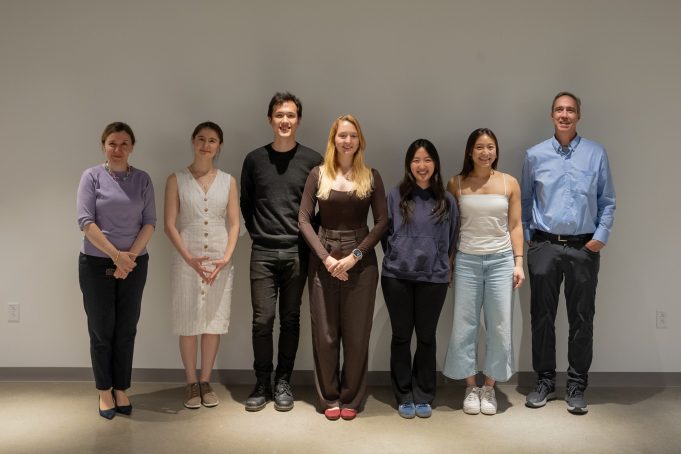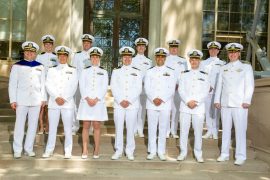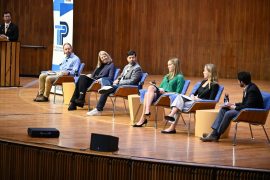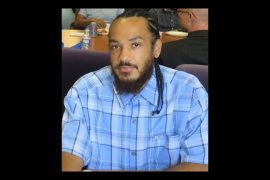A sounding board for strengthening the student experience

Composed of "computing bilinguals," the Undergraduate Advisory Group provides vital input to help advance the mission of the MIT Schwarzman College of Computing.
During his first year at MIT in 2021, Matthew Caren ‘25 received an intriguing email inviting students to apply to become members of the MIT Schwarzman College of Computing’s (SCC) Undergraduate Advisory Group (UAG). He immediately shot off an application.
Caren is a jazz musician who majored in computer science and engineering, and minored in music and theater arts. He was drawn to the college because of its focus on the applied intersections between computing, engineering, the arts, and other academic pursuits. Caren eagerly joined the UAG and stayed on it all four years at MIT.
First formed in April 2020, the group brings together a committee of around 25 undergraduate students representing a broad swath of both traditional and blended majors in electrical engineering and computer science (EECS) and other computing-related programs. They advise the college’s leadership on issues, offer constructive feedback, and serve as a sounding board for innovative new ideas.
“The ethos of the UAG is the ethos of the college itself,” Caren explains. “If you very intentionally bring together a bunch of smart, interesting, fun-to-be around people who are all interested in completely diverse things, you’ll get some really cool discussions and interactions out of it.”
Along the way, he’s also made “dear” friends and found true colleagues. In the group’s monthly meetings with MIT Schwarzman College of Computing Dean Dan Huttenlocher and Deputy Dean Asu Ozdaglar, who is also the department head of EECS, UAG members speak openly about challenges in the student experience and offer recommendations to guests from across the Institute such as faculty who are developing new courses and looking for student input.
“This group is unique in the sense that it’s a direct line of communication to the college’s leadership,” says Caren. “They make time in their insanely busy schedules for us to explain where the holes are and what students’ needs are directly from our experiences.”
“The students in the group are deeply interested in computer science and AI, especially how these fields connect with other disciplines. They’re also passionate about MIT and eager to enhance the undergraduate experience. Hearing their perspective is refreshing — their honesty and feedback have been incredibly helpful to me as dean,” says Huttenlocher.
“Meeting with the students each month is a real pleasure. The UAG has been an invaluable space for understanding the student experience more deeply. They engage with computing in diverse ways across MIT, so their input on the curriculum and broader college issues has been insightful,” Ozdaglar says.
UAG program manager Ellen Rushman says that “Asu and Dan have done an amazing job cultivating a space in which students feel safe bringing up things that aren’t positive all the time.” The group’s suggestions are frequently implemented, too.
For example, in 2021, Skidmore, Owings & Merrill, the architects designing the new SCC building, presented their renderings at a UAG meeting to request student feedback. Their original interiors layout offered very few of the hybrid study and meeting booths that are so popular in today’s first floor lobby.
Hearing strong UAG opinions about the sort of open-plan, community-building spaces that students really valued was one of the things that created the change to the current floor plan. “It’s super cool walking into the personalized space and seeing it constantly being in use and always crowded. I actually feel happy when I can’t get a table,” says Caren, who has just ended his tenure as co-chair of the group in preparation for graduation.
Caren’s co-chair, rising senior Julia Schneider, who is double majoring in artificial intelligence and decision making and mathematics, joined the UAG as a first-year to understand more about the college’s mission of fostering interdepartmental collaborations.
“Since I am a student in electrical engineering and computer science, but I conduct research in mechanical engineering on robotics, the college’s mission of fostering interdepartmental collaborations and uniting them through computing really spoke to my personal experiences in my first year at MIT,” Schneider says.
During her time on the UAG, members have joined subgroups focused around achieving different programmatic goals of the college, such as curating a public lecture series for the 2025-2026 academic year to give MIT students exposure to faculty who conduct research in other disciplines that relate to computing.
At one meeting, after hearing how challenging it is for students to understand all the possible courses to take during their tenure, Schneider and some UAG peers formed a subgroup to find a solution.
The students agreed that some of the best courses they’ve taken at MIT, or pairings of courses that really struck a chord with their interdisciplinary interests, came because they spoke to upperclassmen and got recommendations. “This kind of tribal knowledge doesn’t really permeate to all of MIT,” Schneider explains.
For the last six months, Schneider and the sub-group have been working on a course visualization website, NerdXing, which came out of these discussions.
Guided by Rob Miller, Distinguished Professor of Computer Science in EECS, the subgroup used a data set of EECS course enrollments over the past decade to develop a different type of tool than MIT students typically use, such as CourseRoad and others.
Miller, who regularly attends the UAG meetings in his role as the education officer for the college’s cross-cutting initiative, Common Ground for Computing Education, comments, “the really cool idea here is to help students find paths that were taken by other people who are like them — not just interested in computer science, but maybe also in biology, or music, or economics, or neuroscience. It’s very much in the spirit of the College of Computing — applying data-driven computational methods, in support of students with wide-ranging computational interests.”
Opening the NerdXing pilot, Schneider gave a demo. She explains that if you are a computer science (CS) major and would like to create a visual presenting potential courses for you, after you select your major and a class of interest, you can expand a huge graph presenting all the possible courses your CS peers have taken over the past decade.
She clicked on 18.404 (Theory of Computation) as the starting class of interest, which led to class 6.7900 (Machine Learning), and then unexpectedly to 21M.302 (Harmony and Counterpoint II), an advanced music class.

“You start to see aggregate statistics that tell you how many students took each course, and you can further pare it down to see the most popular courses in CS or follow lines of red dots between courses to see the typical sequence of classes taken.”
By getting granular on the graph, users begin to see classes that they have probably never heard anyone talking about in their program. “I think that one of the reasons you come to MIT is to be able to take cool stuff exactly like this,” says Schneider.
The tool aims to show students how they can choose classes that go far beyond just filling degree requirements. It’s just one example of how UAG is empowering students to strengthen the college and the experiences it offers them.
“We are MIT students. We have the skills to build solutions,” Schneider says. “This group of people not only brings up ways in which things could be better, but we take it into our own hands to fix things.”


